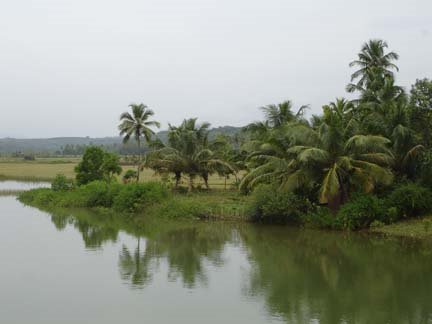 Map showing the locations of ancient 'Alupe' and 'Kulashekara' in the eastern part of present Mangalore city. Blue shade represents interpreted river water (fluvial courses) of Nethravathy during the cited historical period.
Map showing the locations of ancient 'Alupe' and 'Kulashekara' in the eastern part of present Mangalore city. Blue shade represents interpreted river water (fluvial courses) of Nethravathy during the cited historical period.One of the questions ignored by historians so far relates to the actual location of the capital or headquarters of the Alupa Kings. It is generally presumed that they were ruling from Mangalore town. But the fact is that there was no town called Mangalur in the beginning of the Christian Era. The name ‘
Mangalapura’ or ‘
Mangaloor’ came into being only after the Malabar Queen Mangale, who was traveling through the town, during late Ninth/early Tenth century CE, died here by ill-health.
Then, what was the name of the town before Tenth century CE?
The Tulunad was ruled by Alupa Kings, possibly since the beginning of Christian era till the region was occupied by the rule of Vijayanagara Kings. Nature of the word ‘Alupa’ has been discussed by many of the earlier historians. One of the interpretations suggested that Alupa was indicative chieftain status of the rulers that were generally subservient to the Kannada Kings. (‘aaLu’ (=rule) + ‘upa’ (=subordinate) or subordinate ruler).Some have suggested that Alupa name came from the ‘aluve’(estuary) of Mangalore city.
KudalaOne of the important facts regarding the history of Mangalore town is that it has changed its geographic form several times during the last two thousand years! The two rivers Gurupur and Nethravathy joined together near the Sea, giving the name ‘Kudala’ to the town. The word Tulu word ‘
Kudala’ means joined (= kooD ) rivers (=aala ).And these two rivers joined together near
Kudroli in the past and not near Bengre and Ullal as it is at present!
Alupe Kings!But the analysis of the available historical and spatial data shows that the Alupa Kings were not ruling from Kudala, but from Alupe! Yes, they were ruling from Alupe, so they were called Kings of Alupe. However, Kannada inscriptions and writers stylized the word ‘Alupe’ into ‘Alupa’. Consequently, the original Alupe town was totally ignored by the historians!
The ancient Alupe habitation still survives in eastern part of present Mangalore city, located between Kankanadi and Padil. The word Alupe, apparently, derived from Early Munda languages, means the town by the side of River.(
Aal=river,+
upe=town, habitation. There are several similar sounding place names in the District: Alupe, Bajape, Didupe etc.).
KulashekaraTwo of the Alupa Kings were called Kulashekara I and Kulashekara II (early 14th century CE). The place Kulashekara, north of Alupe in the present Mangalore city, is named after the said Kings.
It is suggested that archeologists and historians should investigate these Alupe-Kulashekara and surrounding areas for any possible clues and evidences for reconstruction of the past history.
®



